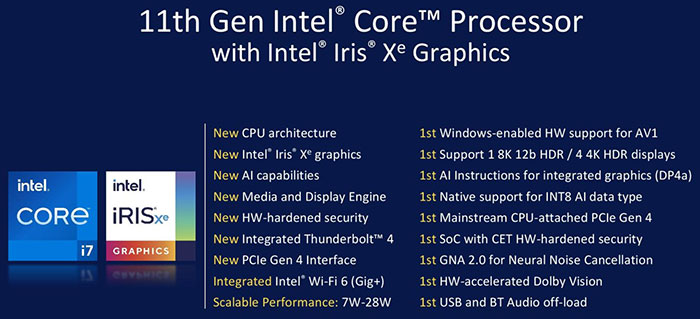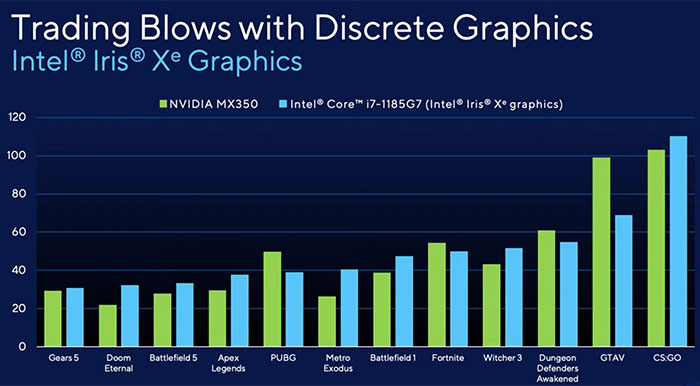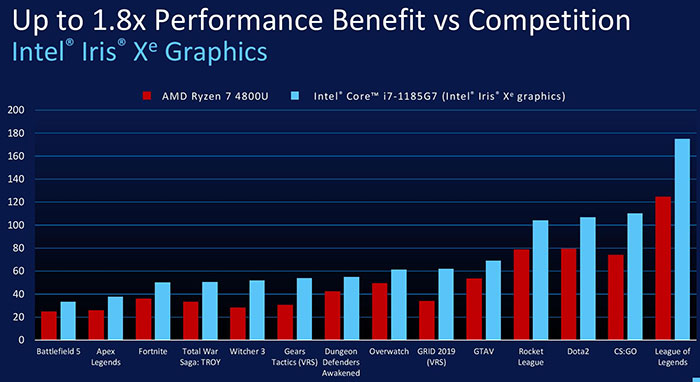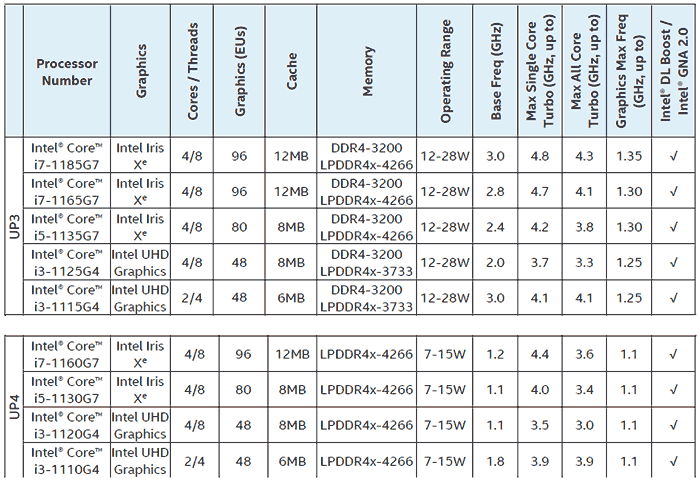The 11th Gen Intel Core processors with Intel Iris Xe graphics have been launched this afternoon at the 'Tiger Lake Virtual Launch Event'. People have been expecting Tiger Lake to cause quite a stir, and we have been teased with various performance claims since CES at the start of 2020. More recently, this summer, it was particularly interesting to see Intel's Chief Performance Strategist, Ryan Shrout, show off a svelte modern laptop which was capable of playing EA's Battlefield V at 1080p HQ on a laptop with no dGPU on board.
The tech behind TGL-U
Intel Architecture Day only served to heighten expectations as it officially took the wraps off 10nm SuperFin technology, claimed to deliver the "largest single intranode enhancement," in its history. Moreover, Intel talked in some detail about the Willow Cove cores that will be made using 10nm SuperFin tech and accompanied by Xe-LP graphics to create these SoCs.

In today's launch we got some more info about Tiger Lake (aka TGL-U or the Intel 11th Gen Core mobile processors with Iris Xe graphics), especially about the Xe graphics component. Intel claims the new Intel Iris Xe graphics outperform 90 per cent of the discrete graphics paired in this segment and offers, in its own parlance, up to 96 EUs and up to 16MB of L3 cache.

Thanks to the beefier iGPU 'new gaming experiences' are promised. Some games were singled-out as being playable for the first time on Intel integrated graphics. AAA titles like Borderlands 3, Far Cry New Dawn, Hitman 2 and others are all playable at 1080p now, according to the chipmaker.

Other SoC enhancements have been engineered for rich collaboration tasks - utilising Intel Gaussian and Neural Accelerator 2.0 (Intel GNA) for background noise suppression, AI-accelerated background blur and video super-resolution, video decode, and integrated Intel Wi-Fi 6, for example. In advanced content creation Intel touts up to 2.7x faster real-world photo editing and up to 2x faster real-world video editing versus competitive products. Furthermore, the TGL-U SoCs have built-in support for 8K display output (or up to four 4K HDR displays) and support Dolby Vision for immersive content whilst reducing system power usage by up to 20 per cent.
Other important features of the platform include the introduction of hardware-hardened security with integrated Intel Control Flow Enforcement Technology (CET) and Intel Total Memory Encryption. Thunderbolt 4 connectivity is standard too, with support up to four ports for charging, data and video. Last but not least, TGL-U is the first mobile client SoC with CPU-attached PCIe Gen 4 interface and with up to four lanes.
The processor family
Above we have plenty of claims from Intel's new-and-improved graphics pertaining to beating the Ryzen 7 4800U chip's Radeon Vega iGPU from rival AMD, but we will have to await real-world tests to validate these and the position of the 11th Gen Core mobile processors with Iris Xe graphics in the desirability stakes. It's not lost on us that Intel decided to forego direct CPU-to-CPU comparisons in its presentation. In the meantime, at least we can check over the product matrix available to system builders.

Above you can see Intel has a pretty wide range of options for systems makers, with two to four physical cores and four to eight threads, boosting up to 4.8GHz (single core turbo), accompanied with an Xe GPU with between 48 and 96 EUs and running at up to 1.35GHz. The range will operate across the 7W to 28W thermal envelope. This means that Intel still trails AMD in the core-and-thread count in the high-visibility Ultrabook market.
Intel Evo
You might have spotted HP mentioning that it had an Intel Evo platform-branded offering if you watched through the leaked promo videos from Walking Cat earlier this week. This validation program uses an intensified testing methodology following the Project Athena second edition specification which has raised the bat for key experience indicators (KEIs).
"The new Intel Evo platform brand represents the best laptops designed to help you focus and get things done no matter where you are," says Intel. More specifically, they need to, at a minimum, deliver:
- Consistent responsiveness on battery
- System wake from sleep in less than 1 second
- Nine or more hours of real-world battery life on systems with FHD displays
- Fast charging with up to 4-hour charge in under 30 minutes on systems with FHD displays
Intel Evo also includes best-in-class wired and wireless connectivity with integrated Thunderbolt 4 universal cable connectivity and Intel Wi-Fi 6 (Gig+), as well as premium audio, webcam and display. All this in a thin-and-light form factor.
Lastly, Intel says that it already has >100 design wins for its 11th Gen Intel Core processors from the likes of Acer, Asus, Dell, Dynabook, HP, Lenovo, LG, MSI, Razer, Samsung and others. How many of these will be Intel Evo-certified badge-wearing designs wasn't stated.
What do you think? Does 11th Gen Core mobile, aka Tiger Lake, get your excited?













